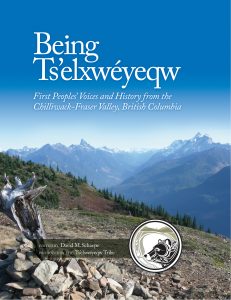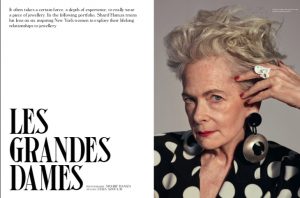This is video put out by Friesens, an excellent Canadian book printer, that explains the entire process of printing a book. If you’ve ever wondered what the process is in creating and producing a printed book, this provides a good demonstration.
Friesens Book Division Video
Being Ts’elxwéyeqw

This new book that is produced by the Ts’elxweyeqw Tribe, uses design by Jan Perrier was published in January 2018. One feature of this book is that Dave Schaepe (the editor) wanted to avoid chapter numbers that indicated a hierarchy or importance of order. Instead we conveyed the sense of location in the book through the use of colour bars which are on the table of contents but also run down the side of the book pages. I have been very fortunate to have worked on these types of projects which include cartography and design. Here is a description and reviews about the contents from the back of the book:
BEING TS’ELXWÉYEQW provides an in-depth and personal view of the First Peoples of the Chilliwack River Watershed in the Central Fraser Valley, British Columbia. This book focuses on two key questions – what does the word Ts’elxwéyeqw mean? And, what does it mean to be Ts’elxwéyeqw, as a tribe of Stó:lō-Coast Salish People? Presented here are key narratives of the distant past and personal histories; over 700 historic and contemporary photographs, maps and images of Ts’elxwéyeqw people, places and belongings; and more than 85 place names within the Chilliwack Watershed that help convey answers to these core questions. This is an original volume with an arrangement and presentation of voices of Elders past, present and future. It contributes to achieving a better relationship and understanding of how to live together in a good way in today’s world.
For more information about the project, please contact the Stó:lō Research and Resource Management Centre
To purchase a book, you can contact the publisher: Harbour Publishing
REVIEWS
“The way this book is put together reminds me of the way the Elders talked to me when I was growing up. They would give you part of something and let you figure out the rest.
It represents a traditional Coast Salish education model. It may be challenging to some of our young people, but it is important to bring back our way of doing things, including teaching and learning.”
T’xwelátse (Herb Joe),
Tzeachten First Nation member, Cultural Practitioner, University Instructor and Social Worker
“In its many voices, this powerful book confirms the long and ongoing occupation of today’s Chilliwack Valley by the Ts’elxwéyeqw people. Readers will come away with a deep appreciation of the depth of the Tribe’s connection to this place and their continuous governance of it. Most of all, they’ll be impressed by the enduring distinctiveness of Ts’elxwéyeqw culture in the face of sometimes extreme pressures.”
J.B. MacKinnon,
Acclaimed Author and Journalist
“THIS VOLUME IS A RICH, challenging, and visually compelling montage of Indigenous history and contemporary experience in the Fraser Valley. For settlers, this material may open up vistas to understanding their Stó:lō neighbours. For Ts’elxwéyeqw, it may serve this same purpose within their own community at the same time as representing a validation and culmination of stories, images, and landscapes known since childhood.”
Natasha Lyons,
Anthropologist / Archaeologist, Ursus Heritage Consulting / Simon Fraser University
“BEING TS’ELXWÉYEQW EMPHASIZES IMAGERY and the voices of past and present community members, while avoiding a master narrative. Many of the passages are fascinating and moving. The volume sets out to make clear what it means to belong to a particular tribe. This is done suggestively and by showing the connections between identity, land and water, ancestry, and culture. In conformity with Coast Salish culture, there is a larger meaning to the text and everyone will understand in their own way. And the publication has virtuosity—it reveals and is based on many years of work and deep connection to the community by the editor and the deep participation of the community in the project.”
Bruce Granville Miller,
Professor, Department of Anthropology, University of British Columbia
Design inspiration
She’s all about creating her own style, trusting her gut and aging has nothing to do with being in style. An amazing woman and certainly inspirational to me!
Design to influence change
Harry Beck created a new kind of map that is began in London and the design is now used world-wide. This is an inspiring story and a great demonstration of thinking outside of the box.
https://www.facebook.com/SmallThingBigIdea/videos/1328242957321729/
About Harry Beck:
https://www.theverge.com/2013/3/29/4160028/harry-beck-designer-of-iconic-london-underground-map
